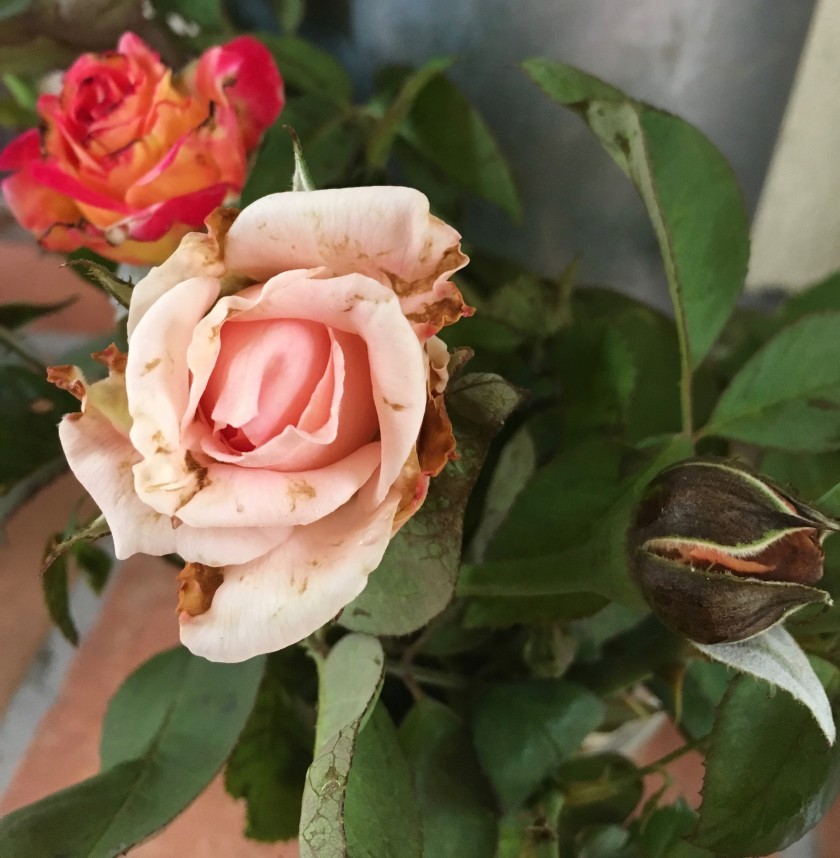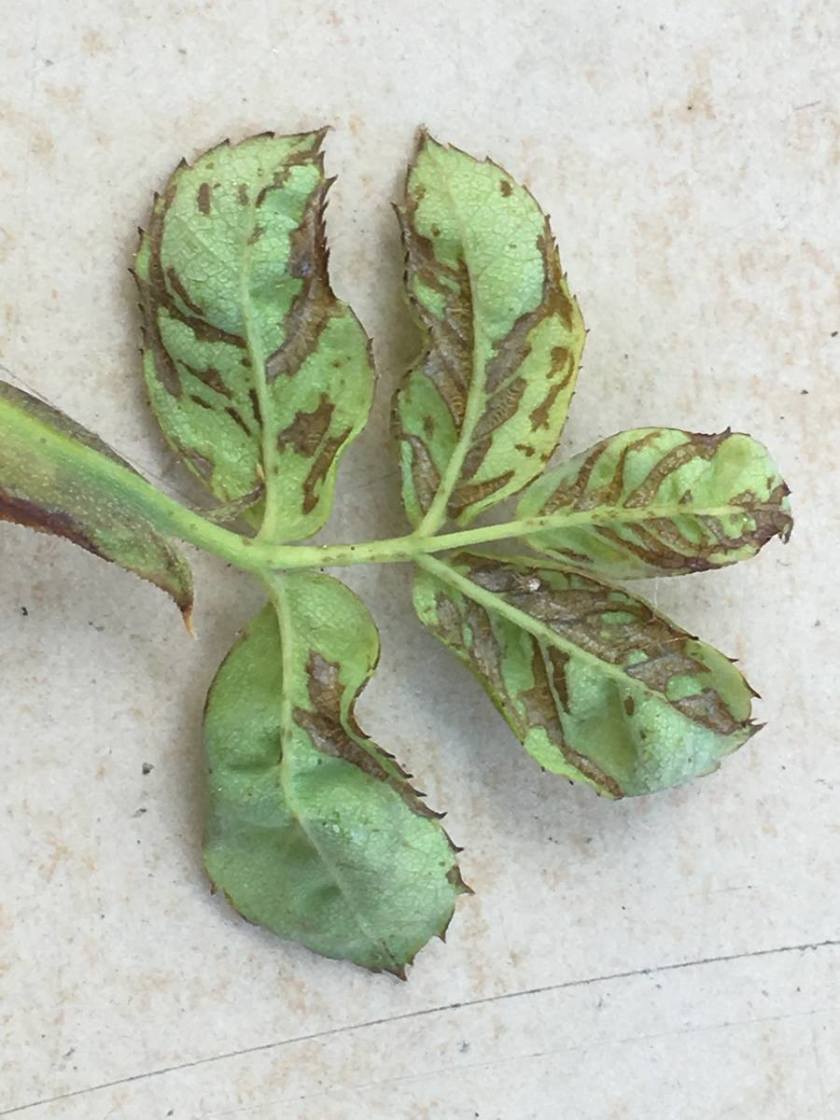Tiny pest poses big rose garden problem

Deformed and discolored blooms indicate a chilli thrips infestation. The rose in the foreground is Marilyn Monroe. Photo - Rita Perwich
Presence of near-invisible chilli thrip detected by deformed, discolored blooms
By RITA PERWICH (This article first appeared in the San Diego Union-Tribune on April 4, 2019)
When I was a child, I was scared of the jabberwocky and other similar monsters. I outgrew those fears, but I am presently filled with even greater anxiety about chilli thrips, a pest that arrived in many gardens in San Diego last summer and is likely to be a big problem this year. You have been warned. Be on the look out for damage daily.
Here is what you need to know about chilli thrips:
Identifying chilli thrips: This is an enemy we can’t see with the naked eye. Chilli thrips are very small, only 0.016 to 0.024 of an inch in length, which is about one-quarter the size of western flower thrips. You will know you have chilli thrips in the garden only when the new foliage and blooms on your roses are already damaged. Rose blooms will be deformed and discolored, and the outer petals will be darkened. Buds will be distorted and may not even open. Unlike the western flower thrips, which favor mainly light-colored blooms, chilli thrips don’t have a preference. They love all bloom colors. And unlike the western flower thrips, chilli thrips aren’t satisfied with just the buds and blooms. They attack the fresh new foliage. You will see misshapen and distorted new foliage and bronzing on the back of the new leaves. The amount of damage they can do in a very short time is astounding! It is imperative to notice the earliest stages of an attack upon your rosebushes since a severe infestation of chilli thrips can defoliate a rose plant rapidly. And while you are out checking your roses, check your other plants, too.

Misshapen and distorted new foliage and bronzing on the back of the new foliage exhibit the rasping damage caused by chilli thrips. Photo: Baldo Villegas
Host plants: Chilli thrips don’t limit themselves to roses. They are known to attack many other ornamental plants in the garden such as begonias, jasmine and chrysanthemums. Fruits they attack include strawberries, blueberries, kiwis, grapes, mangos and citrus. In your vegetable garden, keep watch on your tomatoes, beans, chilies and peppers. This pest also attacks crops such as soybeans, tobacco, corn, tea, cocoa and cotton. Scientists believe chilli thrips originated in Asia. They were first detected in the United States in Florida on roses in Palm Beach in 2005. They made their way through the southern states and by 2008 were well established in Texas. Chilli thrips were first confirmed in California on residential roses in Anaheim in 2015.
Life cycle: The life cycle stages of chilli thrips include a microscopic egg which is laid by the adult inside plant tissue, a first and second instar larvae and a prepupa and pupa. The larvae and adults are the only feeding stages. Both the young and mature thrips use piercing and sucking mouthparts to extract sap from young leaves, buds and blooms. When the second instar larvae are ready to molt into the pupal stage, they usually enter the soil or litter beneath the rose plant. After prepupal development is completed, the insect molts into the pupal stage. The adults do not technically fly but are capable of dispersal by wind over long distances as they have a dense fringe of long hairs on slender wings. They are a year-round pest but are less destructive during cool and wet weather mainly because in hot weather they reproduce quickly from egg to egg in 11 days. In cooler weather the life cycle, from egg to egg, takes approximately 40 days.
Control: Integrated Pest Management stresses the importance of cultural, mechanical and biologic controls before resorting to the use of the least toxic chemical controls. In all the years I have been growing roses by following the cultural, mechanical and biologic controls of IPM, I have not needed to get to the last rung, that of chemical control. This may have to change, as I am told by Bob Martin, master rosarian and president of the American Rose Society, and Tom Carruth, renowned hybridizer and curator of the Huntington Garden, that an infestation of chilli thrips cannot be wiped out without the use of chemicals. Since the complete life cycle for chilli thrips can occur in less than two weeks’ time, you must detect damage and implement a method of control right away.
Start with the preventive controls — cultural, mechanical and biologic. Monitor the rose garden daily. You must cut out damaged buds, blooms and leaves. Remove all fallen leaves and petals out of the garden immediately as part of the life cycle of this pest enters the soil or litter beneath the rose plant. The champion and hero in the fight against chilli thrips in our gardens is the minute pirate bug, which feasts on all the life stages of this pest. The good news for the future is that researchers are having success with two biologic controls: a predatory mite, which has shown effect in greenhouses in controlling the larval stage of chilli thrips, and nematodes that parasitize female thrips and make them incapable of laying eggs.
Chemical controls: If this becomes necessary, choose the least toxic spray, and read and follow the label. During an infestation, the new growth will need to be sprayed weekly. Conserve or Captain Jack’s Deadbug Brew Concentrate are two organic sprays that are used to eradicate chilli thrips. Their active ingredient, Spinosad, will not harm ladybugs, green lacewings, minute pirate bugs and predatory mites. But use great caution, as it will harm bees if it comes in contact with them. Always take the precaution of spraying very early in the morning or in the evening, after the bees are done working for the day.
There is a saying, “the garden grows best when the shadow of the gardener is there frequently.” This is especially true with chilli thrips. Your alert attention will make all the difference.
Perwich is a member of the San Diego Rose Society, a Consulting Rosarian and a Master Gardener with UC Cooperative Extension.

